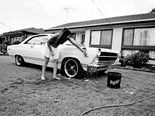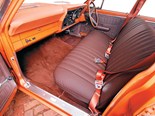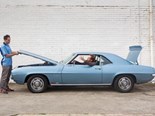Car Auctions Advice
 Car Auctions
Car Auctions

 Car Auctions
Car Auctions

 Car Auctions
Car Auctions

 Car Auctions
Car Auctions

 Car Auctions
Car Auctions

 Car Auctions
Car Auctions

 Car Auctions
Car Auctions

 Car Auctions
Car Auctions

 Car Auctions
Car Auctions

 Car Auctions
Car Auctions


|
|
Car Auctions
|

|
|
Car Auctions
|

|
|
Car Auctions
|

|
|
Car Auctions
|

|
|
Car Auctions
|

|
|
Car Auctions
|

|
|
Car Auctions
|

|
|
Car Auctions
|

|
|
Car Auctions
|

|
|
Car Auctions
|
Ever wondered what goes on at a car auction, or what you need to buy before you buy or sell? Craig Parker gives the low-down

|
|
Car Auctions
|
Car Auctions
HAMMER TIME
Auctions Are A great place to score that hard-to-find ride, but there are plenty of traps for inexperienced players
Let your money make you happy! Why not buy that classic or collectable car you’ve always wanted? After all, you can’t take cash with you. Given the rise in popularity of classic and collectable car auctions, it’s obvious a lot of people are thinking along the same lines. So what is involved in buying and selling cars at auction? What are the hints and tips as well as the dos and don’ts? We spoke to a few insiders to get the low down.
LET'S MAKE A DEAL
Auction houses are not charities, they’re businesses. They make their money by charging an entry fee and a percentage of the sale price. Both these amounts vary depending on whether you put a reserve on the lot. With Shannons, no-reserve lots attract a $440 entry fee and nine percent of the sale price. For reserve-lots it’s $550 and 11 percent.
No-reserve is the recommended route, unless your vehicle is something intrinsically unique, like a Model T or Citroën SM, which are only likely to appeal to a very narrow market. With reserve lots, it’s not uncommon for bidders to attend the auction and not place a bid (hoping it will get passed in), so that they can place a substantially lower bid afterwards. Reserves also scare-off the bargain hunters, who can often be coaxed into bidding.
With non-reserve lots, the car will be sold there and then. If someone wants the car, they’ll have to be there and outbid any other interested parties. Invariably, no-reserve lots generate far more robust bidding, which is the key to fetching a good price (see It’s Just Emotion).
SPREAD THE WORD
For their commission and fee, auction houses will verify the vehicle’s authenticity (to the best of their ability), get an independent mechanical inspection, detail the car, safeguard and present any relevant documentation, as well as promote the sale through major national newspapers, magazines and their websites. If you’re looking to bid farewell to a car with worldwide appeal (say a 1912 Rolls Royce, or Ferrari Daytona), they will promote it globally. Shannons also promotes its auctions through the 600 car shows they attend annually, as well as distributing 20,000 colour brochures.
To turn a profit, the vehicle must sell. Therefore classic and collectable auction houses often reject quite a number of cars. The three major reasons are: it’s not deemed to be special enough, it’s in very poor condition, or the seller has unrealistic expectations. We’re all guilty of the last one, as we all think our pride and joy is worth more than it really is.
STRAIGHT-A-REPORT
If the mechanical report is unfavourable, sellers are advised to attend to the issues, or the expected value will need to be revised. In severe cases the auction house may refuse to proceed with the sale.
There are many simple, little things you can do to add value and desirability to your car. Give the underside and engine bay a good clean, and it’s amazing the visual difference a set of new hoses and plug leads can make. All five tyres should match and be in good nick. Some new blinker, side-marker and taillight lenses could be a good investment. Get it wheel-aligned if it doesn’t drive well. And work on eliminating as many squeaks and rattles as you can. A couple of weekends out in the garage can add thousands to the value.
The exception would be if your vehicle is very original and untouched. An honest car left alone (warts ‘n’ all) is probably more desirable than one that’s obviously been tarted up for resale.
ENLIGHTENMENT
Supply as much documentation as possible. Log books, receipts of all monies spent along with photographs (even photo albums) of any restoration work or modifications. Where circumstances dictate, sellers are put in contact with buyers to answer questions and supply detailed and additional information.
Better still, prepare a proper presentation, usually in the form of a notated scrapbook or information flyer. This can highlight and explain all the work that went into the car and any potential buyer can be made aware of the vehicle’s history. An impressive chronicle will definitely make the buyer more appreciative and motivate them to pay top dollar.
BIDDERS PLEASE
Three golden rules of buying at auction: Know what your limit is, do your research and, finally, do your research.
Auction houses trade on their reputation. So it’s in their best interests to ensure the authenticity of any claims, along with modifications or enhancements. If they have reservations but the owner is resolute, they will probably reject the sale.
Mind you, they know full well they’re not infallible. Hence the need for their bluntly-worded disclaimer – the onus is on the buyer to decide whether any and all claims are true.
On the subject of modifications, if a vehicle is deemed to require an engineer’s report (and one is not supplied), it’s likely the sale will be rejected. Not being able to register a vehicle purchased through them is very undesirable.
A PPSR check will have been conducted, to verify if the car is under finance, if the odometer has been wound back, or if the vehicle has been written-off, stolen or flood/ storm-damaged. And remember to factor in the buyer’s premium, especially on cheaper cars. With Shannons, it’s a fixed $500, however some auction houses charge a percentage of the sale price.
And just for our novices, be aware that no car is perfect. They all have some fault or other, it’s all matter of what will have to be fixed (frayed seatbelt, bottom-end knock in the engine… ) and what you’re happy to live with (dent in rear quarter, squeaky front suspension… ). If you’re looking for a 100 percent fault-free vehicle, then purchasing a classic car is probably not for you.
KNOW YOUR STUFF
Do your homework, know what it’s worth. Sometimes this is straightforward – i.e. a 186 HG Monaro GTS is less valuable than the Bathurst 350 version. Other times it’s not so straightforward – an auto-equipped, red-with-black interior XA GT is less valuable (in like-for-like condition) than the rarer four-speed-equipped, purple-withwhite-interior combination.
The day or night of the auction is not the time to inspect any prospective purchase – as the vehicles are usually parked in a way that deliberately prevents any reasonable inspection. There will be designated inspection days prior – use this opportunity to carefully look things over. If you’re interstate, get a knowledgeable friend to take a look for you.
If you’re not intimately familiar with the model, take along someone who is. Alternatively, go and look at a few other examples. This way you’ll know where it sits in the grand scheme of things in regards to condition, specification and value.
Finding other examples of rare, unusual or highly-collectable cars is certainly going to be difficult and this is where taking along an ‘expert’ can be a god send.
There are car clubs for everything, get in contact with them. They may have knowledge of the car, or may even offer to come along and have a look at it for you. Another trap is changing focus. Don’t go to town researching Mustangs and then go and have a big lunge at that nice ’Cuda you’ve just spotted. Such changes of heart are fraught with danger and raise the odds of getting burned.
One last trueism: if it looks too good to be true, it probably is.
GET REGISTERED
You cannot bid without registering prior to the auction, which I thoroughly recommend regardless of your intentions. Why? A year ago, I was sticky-beaking at a damaged vehicle auction, with no intention of buying anything. While I was there a six-speed manual, VX Commodore SS with mild rear damage went for $2200!
I was about to pay more than that for the gearbox alone! By wrecking out the perfectly salvageable LS1 and pristine SS interior, I could have probably ended up with a free gearbox! Always register…
AUCTIONEERING
The auctioneer acts solely as an agent for the vendor. If a lot is falling short of the reserve, he’ll say things like, "only a few thousand more will buy you this car". However, once the auctioneer announces, "it’s on the market", bidding usually heats up. That’s when things get serious, as the lot can be sold at the next drop of the hammer. So once you hear those magic words, don’t dilly-dally about or get too cagey.
IT'S JUST EMOTION
Be under no illusion – bidding on that special or desirable car is an emotional thing, it’s an adrenalin rush. People will often get caught up in a frenzy, or make it personal (i.e. I don’t want the other guy to get it) and bid above their limit or what they’d pay on the open market. This is what the vendor is hoping for – the case of a couple of GT-HOs a few years ago springs to mind.
Another common scenario is: my wallet’s bigger than yours and I’m going to prove it. You and your bank balance (or lack thereof) may not feel so good the next day when the euphoria of the victory wears
off.If you feel you may get caught up in the heat of the moment, get someone else (with no emotional attachment or vested interest) to bid for you – don’t even be there. I often hear people bemoan, "I could’ve won with just one more bid." Bollocks! You don’t know if the other bidder was willing to go significantly higher. You can never really know. Set your limit and stick to it.
If you’re dead set on having something, make an offer prior to the auction. You may be lucky and pick it up for a price you can afford – not the amount you were forced to bid.
STRATEGY
Ask 10 people and you’ll get 10 different recommendations. First up, auction houses advise against bidding on your own car – it can easily backfire. If it’s a no-reserve auction, it’s best to let it run itself. That said, most allow the auctioneer to place one bid on behalf of the vendor, which is clearly announced.
The two most common strategies seem to be come in late, so other bidders are not alerted to your interest. Or come in early and strong. I’ve seen cars go for over $100,000 that initially struggled to attract bids in the $50,000 region. Here, a strong $80-90,000 opening bid could well have won the auction as the adrenalin, emotion and anticipation levels have yet to build.
Watch the phone bidders, which must be organised prior to the auction. Representatives stand off to the side and have buyers on the phone placing bids – they’re clearly identifiable as they must also hold up their bidding cards. Make sure you note were the phone bid representatives are located before getting into a bid. Establish eye contact with the auctioneer as well as one of the runners. This will ensure your bid is acknowledged and is especially important as the hammer’s about to fall.
PAY UP
Congratulations, you won! At the fall of the hammer, you’re required to stump up 10 percent there and then. Mind you most auction houses are flexible with highly-priced vehicles.
The most common payment method is credit card or cash. Business or personal cheques may be accepted, however, I’d make prior arrangements. Direct debit is also problematic, as the transfer is not verifiable until the next day.
Regardless, the vehicle will not be released until the balance is paid in full within two business days. If you fail to pay up, you’ll get a very nasty solicitor’s letter, which I’m told is extremely persuasive. If you don’t have the money, don’t bid. If you’re seeking finance, have it sorted prior to the auction, there’s insufficient time to organise it afterwards.
Before making final payment (and again when taking delivery of the vehicle), thoroughly inspect it, to ensure it hasn’t sustained any damage and everything is still as it was when you last sighted it.
PROS & CONS
Auctions have their pros and cons and you can easily pick up a bargain. Mind you, most auctions are well attended with no shortage of prospective bidders. With more collectable cars, their authenticity would have been amply scrutinised so the odds of deception are diminished. And even though it will have a mechanical report and it can be started for you, you cannot test drive it. Also, other forms of inspection (peering under carpets or getting the car up on a hoist) can be difficult.
HAVE FUN
Although nail-bitting and intense, auctions shouldn’t be intimidating. Unlike regular auto actions seething with seasoned dealers, at classic and collectable auctions it’s predominately a one-time event for both buyers and sellers.
So it’s a more laid-back, friendlier atmosphere. And don’t be afraid to talk to the other bidders – one of them is most likely going to be the owner!
Hope this helps, now go and let your money make you happy!
TIPS:
01 Prepare and clean your car as well as possible – it will make a difference to the bottom line
02 Always register to bid and when you make a bid, show your number
03 Classic and collectable car auctions are growing in popularity
04 If you’re not sure about a particular model, take along an expert or consult a car club
05 A no-reserve lot has to be sold on the night and usually attracts stronger bidding than reserve lots
06 The calm before the storm. The auctioneer is your friend – make eye contact with him/her
07 Auctions can be tense, nail-biting affairs or a lot of fun; you could be bidding on a Bentley or a Fairlane
08 Go with a plan and don’t be swayed by another car when you arrive, you could lose out
09 Inspect cars before the auction – on the night they’re usually cheek-byjowl, as demonstrated by this EH
10 Cars aren’t the only items on the auction block; memorabilia sells well
11 Sometimes you have to sit through a lot of this stuff before the juicy cars come up, though this old bowser rocks
12 Do your research – a lot of people in the room are seasoned buyers
13 Well done! You’ve survived the auction process and bought a car
14 Keep an eye on auction staff taking telephone bids too
More:
> Visit Shannons website for its next upcoming auctions listing, plus brochures available to download.
> Check out Unique Cars magazine each month for auction results locally and internationally in Auction Action
Unique Cars magazine Value Guides
Sell your car for free right here
Get your monthly fix of news, reviews and stories on the greatest cars and minds in the automotive world.
Subscribe

.jpg)












